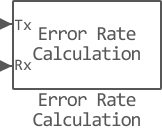Error Rate Calculation
Calculates a bit or character error in the input data.
blockType: ErrorRateCalculation
|
Path in the library: |
Description
The Error Rate Calculation block compares the input data from the transmitter with the input data from the receiver. The block calculates the error rate as a running statistic by dividing the total number of unequal pairs of data items by the total number of input data items from the same source.
You can use this block to calculate the error rate by character or bit because it does not consider the magnitude of the difference between the input data items. If the input parameters are bits, the block calculates the bit error rate. If the input parameters are characters, the block calculates the character error rate.
Ports
Input
Tx - transmitted data
scalar | vector-column
Transmitted data as scalar or vector-column.
| If you specify Tx or Rx input as a scalar, the block compares this value with all elements of the other input. If you specify both inputs as vectors, they must have the same size and data type. |
Data types: Float16, Float32, Float64, Int8, Int16, Int32, Int64, UInt8, UInt16, UInt32, UInt64, Bool
Rx - received data
scalar | vector-column
Received data as scalar or vector-column.
Data types: Float16, Float32, Float64, Int8, Int16, Int32, Int64, UInt8, UInt16, UInt32, UInt64, Bool
Output
Out - difference between transmitted and received data
vector-column
The difference between the transmitted and received data returned in the form of a vector-column [R; N; S], where:
-
R is the error rate.
-
N - number of errors.
-
S - number of samples to be compared.
Dependencies
To use this port, set the Output data parameters to Port.
Data types: Float64
Parameters
Receive delay - received signal delay
0 (by default) | non-negative integer
The number of samples by which the received data lags behind the transmitted data as a non-negative integer. Use this parameters to align the samples for comparison in the transmitted and received input data vectors.
Computation delay - calculation delay
0.0 (by default) | non-negative scalar
The number of data samples the object ignores at the beginning of the comparison as a non-negative integer. Use this property to ignore the transient behaviour of both input signals.
Computation mode - comparison method
Entire frame (by default).
Specify the method of comparing data samples.
-
Entire frame- compare all samples of received data with samples of transmitted frame.
Output data - data output method
Port (By default)
Specify the data output method:
-
Port- send output data to the block output port.
